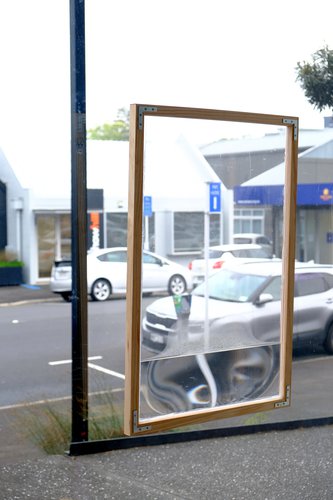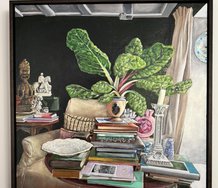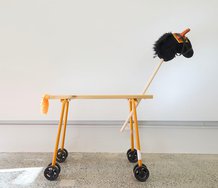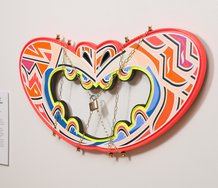Peter Dornauf – 12 November, 2025
Staying with water and exploring the same theme, artist Hollie Tawhiao has taken a unique approach to her subject in 'Portrait of a Lake as a Dying Person', where she has created a Perspex frame to hold water taken from Lake Taupo. It is thus a ‘picture' of real water, framed and contained inside the device, although with the potential to seep and thus cause a slight disruption in the gallery space—symbolic of the trouble and disorder climate change can and does create.
Assorted Artists
Critical Mass
Curated by Megan Lyon & Julia Christey
16 October - 14 November 2025
What do you get when you cross an art installation with an ornithological display? You get artist Julia Christey’s work, entitled Being and Non-Being. This hybrid construction is the central and somewhat astonishing piece of a larger exhibition currently showing at Ramp Gallery, Hamilton, called Critical Mass.
What the artist has done is collect birds’ nests of all different varieties and suspended them on wires from the gallery ceiling; 120 of them. And it is a sight to behold. One gets up close and personal with these avian architects who have fashioned their homes in a multitude of different and unique ways, ways in which one would never think about until confronted with them, juxtaposed as they are here in such a dramatic fashion - Fantail, Grey Warbler, Blackbird, Swallow, Tui, Rifleman, Mynah and others.
From small to large, tidy and scruffy, or woven with different and diverse techniques, and using different materials, we are witness to the assorted skills, methods and design practices of each bird and it comes as a kind of revelation. It is, looking at these twig creations, as if each bird has a distinct personality. The fact that there are so many variations on a theme, is part of the fascination, the magic of it all. Something so ordinary and largely overlooked is made extraordinary by the method of display, the nests hung at different levels, exhibiting multiple shapes, patterns and design features.
An added ingredient is the employment of sound. Musician, Kent Macpherson, has made field recordings (‘Murmurs’) of the noise, hum, whisper and mutter trees make as they grow and move in their natural environment, and this plays as an atmospheric backdrop to the work.The nests for the most part are empty and here lies the point, which takes the piece to another level. It is “an encounter with absence”, as the artist explains, which transports the viewer into the territory of ecological concern.
And this is reinforced by a second work of Christey’s called Silence of Birds, which obviously invokes the famous text, Silent Spring, by Rachel Carson, the first voice in the 1960’s to raise alarm at environmental damage and degradation.
What the artist has done here is take her nests and use them as a kind of paint brush by dipping them in black ink and creating circular patterns by pressing them on bamboo paper. Habitat loss is thus addressed in her grid of circles that sometime recall Max Gimblett - with reference to the circular symbol of perfection.
Another artist in the show, Jonathan Kay, also engages with similar environment issues, this time climate change and global warming, focusing on the impact this has on our glaciers, in particular the Haupapa Tasman glacier. Having made several visits over an eight-year period, the artist has employed the intensely coloured fabric of cyanotypes to realize the real and detailed physical appearance of ice, which in the work, drapes like a waterfall in the gallery space. Called Cross Section, it taps into the idea of taking ice samples to gauge the history of the frozen phenomena.
Staying with water and exploring the same theme, artist Hollie Tawhiao has taken a unique approach to her subject in Portrait of a Lake as a Dying Person, where she has created a Perspex frame to hold water taken from Lake Taupo. It is thus a ‘picture’ of real water, framed and contained inside the device, although with the potential to seep and thus cause a slight disruption in the gallery space—symbolic of the trouble and disorder climate change can and does create.
James Ormsby’s Kakepuku Enso 3, continues the landscape focus of the show, a representation of and homage to Te Awamutu and its landforms, complete with an Enzo stroke that echoes the circular calligraphic shapes in Christey’s Silence of Birds. That same preoccupation with the circular is found again in Ruth Friedlander’s work, Te Toto Gorge 1 and 11 where the frame is oval or tondo which provides, because of the small scale, a sense of looking through a lens, encouraging reflection that goes beyond a simple depiction of scenery.
The glass works of Lisa Bate, with a title like Dead Pools, continues the concern with nature and ecosystems, particularly issues related to the containment of freshwater. These small works with their dark black rings, have nothing to do with perfection or enlightenment, but rather the opposite; images of pollution and contamination.
Finally, Judith Lawson’s Displaced (acrylic on found wood) completes the series with the simplest of pieces. This is a branch with several boughs, painted black and mounted on another short piece of wood that registers evidence of burning. Effective because of its elementary nature, stark and singular against a white wall, it speaks about deforestation and urban encroachment, a warning about the point of critical mass we are about to encounter.
This is a show that’s timely in its topic focus, and delightful in its various technical approaches to the subject—the charming nest work providing heart to the whole exhibition.
Peter Dornauf

 Advertising in this column
Advertising in this column Two Rooms presents a program of residencies and projects
Two Rooms presents a program of residencies and projects



This Discussion has 0 comments.
Comment
Participate
Register to Participate.
Sign in
Sign in to an existing account.